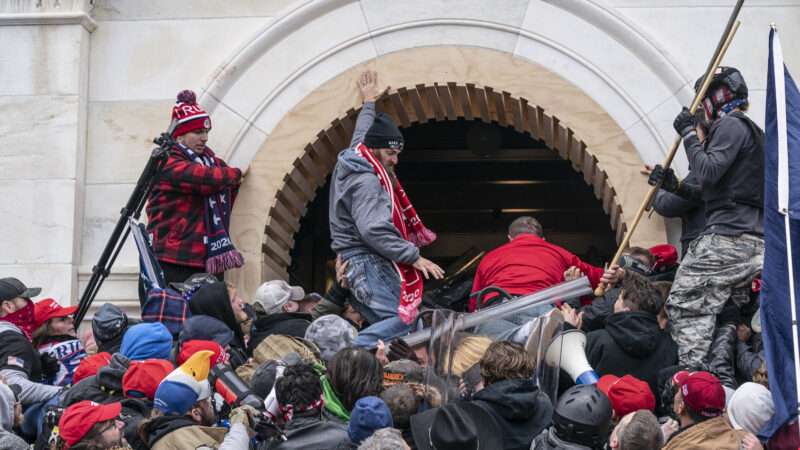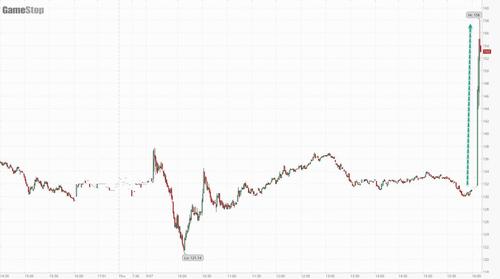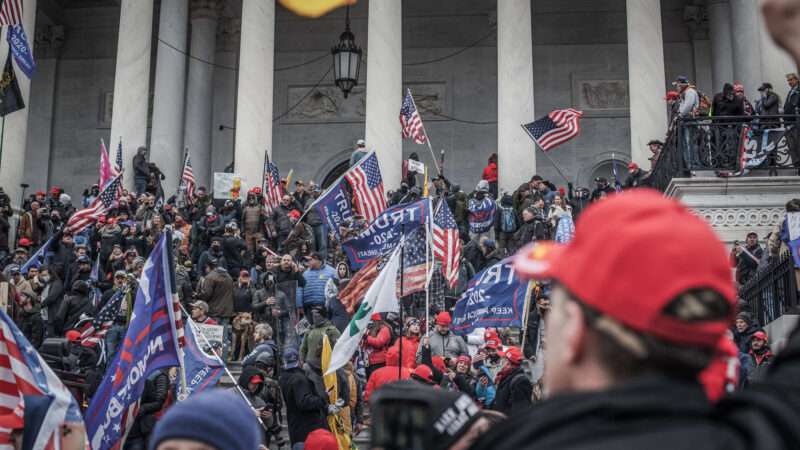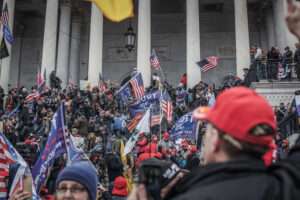Authored by Joseph Hannemann via The Epoch Times,
The hardened-steel baton made the most disturbing sound as it bounced off Victoria White’s skull.
It varied between a hollow click and a deeper snap, depending on where on her head the metal weapon made contact.
“Please don’t beat her!” a man in the crowd yelled.
It was chaos in the West Terrace tunnel entrance of the U.S. Capitol on the afternoon of Jan. 6, 2021. Outside, thousands who had attended President Donald Trump’s “Save America” rally milled about the terrace, while groups of rioters battled police near the tunnel.
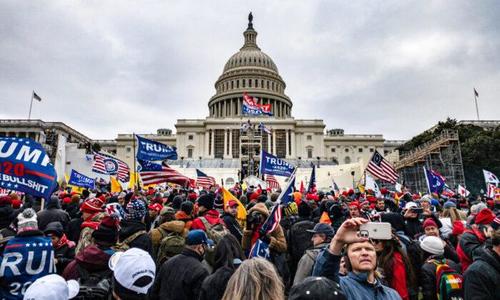
An almost demonic cacophony emanated from under the tunnel arch.
“I didn’t even touch you,” a woman cried. “I need help! I need help,” a man shouted.
“Stand up, dammit!” intoned a police officer in riot gear. “Get out!” boomed another.
Then a blood-curdling scream, followed by the ear-splitting sound of an emergency siren.

Victoria White appears prone or near-collapse in several parts of a five-minute video. (Screen Captures/Joseph McBride)
After repeatedly striking White in the head, the officer in white holstered his baton. Then he made a fist with his bare left hand and punched White in the face.
“Oh, no-no-no! Please! Please don’t beat her!” someone shouted, to no effect.
After three full-force knuckle shots to White’s head, the officer in white paused. Then he went in for two more blows. He grabbed the hair at the back of her head and pulled it hard.
White looked dazed and confused. She wore a blank stare. Another officer reached in with his baton in an apparent attempt to prevent more blows. The officer in white grabbed his colleague’s arm and shoved it back at him.
The almost unbelievable violence meted out on the unarmed, 5-foot-4-inch White provides a stark contrast to the often-preached narrative that Jan. 6 was strictly an insurrection carried out by mobs of Trump supporters wanting to overthrow the government.
White was a victim of brutality. Her lawyer is preparing a civil suit. Hers is one of the hidden stories of Jan. 6, exposed only after a federal judge ordered that three hours of surveillance video held by the U.S. Department of Justice be released to White’s attorney.
Political Divide Widens
The voluminous media coverage in the weeks leading up to the one-year anniversary of Jan. 6 demonstrates the substantial and growing divide between Americans of differing political stripes. The prevailing narrative is that supporters of Trump, whipped into a frenzy by his Jan. 6 speech at the Ellipse, descended on the U.S. Capitol in a violent attempt to upend democracy.
A large crowd of Trump supporters—estimates ranged from 30,000 on the low end to 2 million on the high end—crowded the Ellipse to hear the president rail against the 2020 presidential election. Trump contended, along with millions of supporters, that widespread election fraud in key states like Pennsylvania, Michigan, Georgia, Arizona, and Wisconsin had robbed him of a second term and placed Democrat Joe Biden in an illegitimate presidency.
The speech started approximately an hour later than scheduled. Well before Trump concluded his remarks, a group of protesters breached a lightly guarded barrier on the Capitol’s pedestrian walkway. They quickly headed for the Capitol building. By the time the throngs of rally-goers made the long walk to the Capitol grounds, the perimeter fencing and security signs indicating the site was restricted had been methodically removed.
As tens of thousands of protesters surrounded the Capitol, pockets of violence broke out. Windows were broken, and protesters climbed inside, just after 2 p.m. At other entrances, protesters found doors propped open and proceeded inside like tourists.
The circumstances of the worst violence are hotly contested, but the results were real. Trump supporter Ashli Babbitt, 35, was shot and killed by a Capitol Police officer as she attempted to enter the Speaker’s Lobby. White and others were beaten by police in or near the West Terrace tunnel, attorneys say.
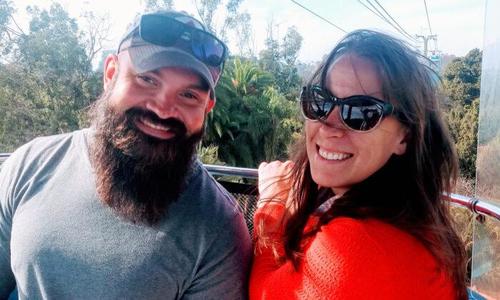
Aaron Babbitt with his wife, Ashli, who was killed at the U.S. Capitol on Jan. 6, 2021. “She loved life,” he said. (Courtesy of Aaron Babbitt)
Some 140 police were injured during battles with rioters. Capitol Police Officer Brian Sicknick died on Jan. 7, 2021, although his death was eventually determined to be from natural causes. Capitol Police Officer Howard Liebengood and Washington Metropolitan Police Officer Jeffrey Smith—both of whom were on duty at the Capitol—took their own lives in the weeks after Jan. 6.
President Joe Biden described Jan. 6 as the “worst attack on our democracy since the Civil War.” The Associated Press asserted it was “the most sustained attack on the seat of American democracy since the War of 1812.” Steven Sund, former U.S. Capitol Police chief, called it “a coordinated violent attack on the United States Capitol by thousands of well-equipped armed insurrectionists.”
Many Americans don’t see those words as hyperbole, insisting Trump-fueled mobs fully intended to disrupt the U.S. Congress and overthrow the federal government.
Across the political chasm are those who reject that dominant narrative, and assert that while Jan. 6 was many things, it was no insurrection. They view that characterization as a convenient way to suppress the truth.
The real Jan. 6 story, they believe, remains hidden on some 14,000 hours of surveillance video from around the Capitol grounds. Portions of that video will undoubtedly be unsealed as some of the more than 725 people arrested for alleged Jan. 6-related crimes go on trial.
Whatever the chaos of that infamous day is called, one thing seems clear. The full Jan. 6 story hasn’t been told. One year later, the legacy of Jan. 6 is a trail of troubling questions—the answers to which could rock American politics and deepen the divide between its citizens.
Is There Evidence of Treason or Sedition?
In response to the violence at the Capitol, the FBI launched one of the most sweeping investigations in its history. Agents pored over cell phone video, social media postings, surveillance video, and police bodycam footage to identify those who were at the Capitol that day. The FBI opened a national tip line and posted videos and photographs of protesters. Tips came from many sources, including neighbors and family members who turned in their relatives.
Of the more than 725 people arrested over the past year, no one was charged with treason or sedition. At least 225 defendants were charged with assaulting, resisting, or impeding police, including 75 who allegedly used a deadly or dangerous weapon, or caused serious bodily injury to an officer.
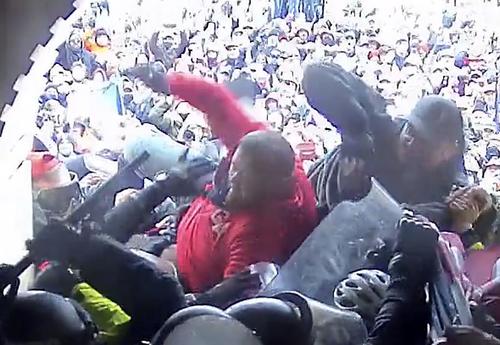
Two men climb over other protesters and lunge at police officers guarding the entrance to the West Terrace tunnel at the U.S. Capitol on Jan. 6, 2021. (Screen Capture via The Epoch Times)
The most common charge issued by federal prosecutors—involving 640 individuals—was for entering or remaining in a restricted federal building or grounds.
About 40 percent of all those arrested were charged with impeding or attempting to impede an official proceeding—the certification of the Electoral College votes from the 2020 presidential election.
Of the 165 people who have pleaded guilty to date, nearly 90 percent of the cases involved misdemeanors. The rest were felonies.
Are There Any Investigative Conclusions?
House Speaker Nancy Pelosi (D-Calif.) appointed a select committee to investigate the Jan. 6 breach and subsequent violence. That group’s work is ongoing. Preliminary findings could be made public by summer. Republican House members are conducting their own probe, but complain that Democrats refuse to cooperate or share records with their GOP colleagues.
The Senate Committee on Homeland Security and Governmental Affairs, and the Committee on Rules and Administration, issued a report on the Capitol breach that cited a range of intelligence and law enforcement failures that enabled the violence.
Among the findings in the Senate report was that neither the FBI nor the Department of Homeland Security issued formal intelligence bulletins about the potential for violence at the Capitol on Jan. 6.
The FBI’s Norfolk field office sent out a situational information report late on Jan. 5, warning of individuals traveling to Washington for “war” at the Capitol, but the agency overall didn’t view as credible online posts calling for violence.
Capitol Police didn’t have a department-wide operational plan or staffing plan for the Jan. 6 joint session of Congress, the report said. It faulted a lack of training in civil disturbances and a failure to provide basic protective equipment to rank-and-file officers.
Who Incited the Capitol Breach and Violence?
Independent media and online sleuths sounded alarms about the presence of unindicted individuals among those who first breached the Capitol at about 12:50 p.m. These men played a central role in the breach, encouraged protesters to go to the Capitol, and directed people into the building. Yet they haven’t been arrested, indicted, or identified by the FBI as among the wanted. Who were they?
A man—now known to be Ray Epps of Queen Creek, Arizona—was captured on video on Jan. 5, 2021, attempting to recruit Trump supporters to assault the Capitol the next day.
“Tomorrow, we need to go into the Capitol,” Epps says, as seen in a video clip. “Into the Capitol!”
A man near him says, “What?” and others are heard shouting, “No!” Then the crowd breaks into a chant: “Fed! Fed! Fed! Fed!”—accusing Epps of being a federal agent.
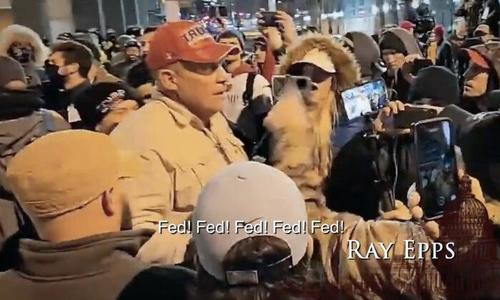
Ray Epps seen on Jan. 5, 2021, trying to recruit men to attack the Capitol. They accuse him of being a federal agent. (CapitolPunishmentTheMovie.com/Bark at the Hole Productions)
Epps gets into verbal sparring with some of the Trump supporters. “You’re counterproductive to our cause,” one young man shouts. Epps shouts back, staying on message: “It doesn’t matter. … That’s not what we’re here for. … You’re getting off the subject. … We’re here for another reason.”
Another video shows Epps saying, “Tomorrow—I don’t even like to say it because I’ll be arrested,” prompting a man nearby to reply, “Then let’s not say it.” Epps responds: “I’ll say it. We need to go into the Capitol!” A young man in the crowd, wearing an American flag neck gaiter, replies, “I didn’t see that coming!”
On Jan. 6, as crowds milled about the Washington Monument in long lines to get in to watch Trump’s speech, Epps could be heard shouting through a megaphone: “As soon as our president is done speaking, we are going to the Capitol, where our problems are. It’s that direction. Please spread the word!”
Epps is seen again in video footage taken at the metal barricades outside the Capitol at 12:50 p.m., as a small crowd chants, “USA! USA!”
He whispers something in the ear of a man wearing a backward Make America Great Again cap. A few seconds later, the young man helps push over the barricade as Epps steps back to watch. This first breach of the security perimeter was 20 minutes before Trump finished his speech. Epps is then seen sprinting with the crowd up the steps toward the Capitol.
A few days after the Jan. 6 violence, the FBI placed a photo of Epps on a “Seeking Information” poster, asking for the public’s help in identifying those who breached the Capitol. He could be seen in Photograph No. 16. That photo has since been scrubbed from the FBI website.
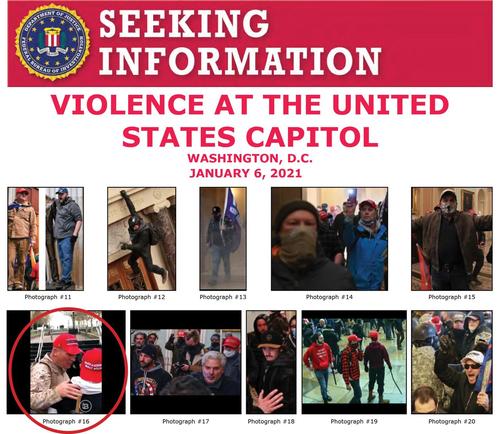
Ray Epps is shown at lower left on an early FBI wanted poster, but his photo has since been scrubbed from the FBI website. (FBI.gov/Wayback Machine)
On the current list of 1,559 photographs of people the FBI wants to identify, there is no longer a No. 16. The list skips from Photograph No. 15 to Photograph No. 17. Epps hasn’t been arrested or charged.
John Guandolo, a former FBI agent and counter-terrorism expert who was on the Capitol grounds on Jan. 6, said he saw FBI agents dressed as protesters.
“For a good portion of the day, I was with law enforcement, FBI, etcetera,” Guandolo said in an interview for the documentary “Capitol Punishment.” “Guys would walk by, and we’d look at each other and be like, ‘Two more right there. Here comes another. There’s another one.’ They were everywhere.”
Revolver, an alternative news outlet, identified others around the Capitol grounds who were active participants in the breach but whose photos weren’t included on the FBI’s wanted list. One man, wearing a grey Bulwark jacket, knit cap, and sunglasses, is seen on video rolling up the green plastic fencing around the security perimeter. He pulls up the stakes and removes the “Area Closed” signs.
A man in a blue cap with a blue bullhorn is seen in multiple videos atop the media tower erected for the inauguration. Dubbed “Scaffold Commander” by online researchers, he barks out directives and encouragement for 90 minutes. “Don’t just stand there! Keep moving!” “Move forward! Help somebody over the wall!” Once the crowd filled in around the Capitol, Scaffold Commander switched gears. “We’re in! Come on! We gotta fill up the Capitol! Come now, we need help!”
Revolver’s video investigation said that whether or not Epps and Scaffold Commander knew each other, their words and actions worked well together. “So we have Scaffold Commander directing the body of the crowd from the tower above, and Ray Epps directing the vanguard front-liners at the police line below,” the Dec. 18 story read. “Yet neither one of them has been prosecuted, nor is either presently ‘wanted’ by the FBI.”
Revolver founder Darren Beattie took to Twitter to ask Epps to expose who his handlers were. “But now, it is time to think for yourself, Ray. Forget about your boat and your ranch and your grill. If you make the right move and tell the truth, you change everything,” Beattie wrote on Dec. 29.
Neither Epps, the FBI, nor federal prosecutors have commented on Epps’s actions that day, on whether he worked for the FBI, or on why he hasn’t been indicted. Epps told an Arizona Republic reporter on Jan. 12, 2021, “I didn’t do anything wrong.”
Rep. Thomas Massie (R-Ky.) asked Attorney General Merrick Garland on Oct. 21 to dispel concerns about the Epps videos, but Garland wouldn’t comment.
“You’ve said this was one of the most sweeping investigations in history,” Massie said during a public hearing. “Have you seen that video, those frames from that video?”
Garland began talking about a standing practice of not commenting on investigative specifics, before Massie interrupted him: “How many agents or assets of the federal government were present on January 6th, whether they agitated to go into the Capitol, and if any of them did?”
Garland’s reply: “I’m not going to comment on an investigation that’s ongoing.”
What Is the Significance of Unindicted Actors?
Attorneys who represent Jan. 6 defendants say if Epps or other participants were FBI informants or agents, then it blows a hole in the idea that Trump supporters were solely responsible for violence at the Capitol. Participation by government actors could legally invalidate conspiracy charges, they say.
Attorney Jonathon Moseley, who represents Jan. 6 defendant Kelly Meggs of Dunnellon, Florida, a member of the Oath Keepers, issued subpoenas to Epps, Oath Keepers founder Stewart Rhodes, and other men who played visible roles on Jan. 6. As Meggs’s April trial on conspiracy charges approaches, Moseley wants to know why Epps was at the Trump rally and Capitol, and whether he was working for the government.
Moseley said Epps was seen at the first breach of a police line at the pedestrian walkway, about 200 yards from the Capitol building. Video shows Epps as he appears to rush the makeshift barricade erected by police, “then stops short,” Moseley said.
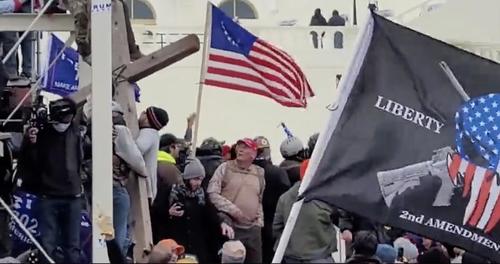
Ray Epps at the U.S. Capitol on Jan. 6, 2021, shortly before pepper gas is shot into the crowd. “Been a long time,” he says after coughing. “Aah, I love it!” (Screen Capture/Rumble)
“It’s like he’s head-faking people to rush with him, but then he never touches it,” he said. “A police officer falls—I think it may be a woman—and his immediate instinct is to go help her, and he thinks better of it and steps back. It really looks like he’s undercover.”
Moseley said the involvement of government-paid actors in facilitating or inciting the breach of the Capitol complex would create reasonable doubt in just about any of the Jan. 6 cases.
“There are legal consultants who keep emphasizing that, legally, you can’t conspire with the government. So if he’s working directly or indirectly for the government, then people are innocent of the conspiracy,” Moseley said. “It’s a legal rule. If there are 10 people conspiring and one of them is with the government, not only could it be entrapment, but it also may invalidate a conspiracy.”
That type of legal issue has been raised in a Michigan case in which a group of men stand accused in federal court of a plot to kidnap Michigan Gov. Gretchen Whitmer, a Democrat. Defense attorneys recently filed a motion to dismiss the case, contending that government agents and informants concocted the kidnapping plan and pushed to convince the defendants to participate.
Are Jan. 6 Detainees Political Prisoners?
Third-world banana republics are notorious for terrible prison conditions and brutal treatment of the accused and convicted alike. Some lawyers, family members, and defendants believe the District of Columbia operates a jail that would be at home in any of those countries. The jail is sometimes called “DC-GITMO,” after the U.S.-run terrorist detention camp in Guantánamo Bay, Cuba.
The poor accommodations at the D.C. jail have long been the subject of discussion in the nation’s capital. The Washington Post said conditions there were “deplorable,” an ironic descriptor, considering who the jail’s primary occupants are these days. The issue got national attention in 2021 because of repeated allegations of brutal, abusive treatment of men accused of Jan. 6 crimes.
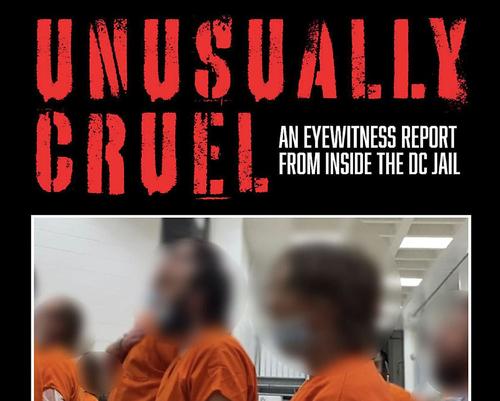
A 28-page report issued in late 2021 by Rep. Marjorie Taylor Greene (R-Ga.) said treatment of Jan. 6 detainees was “inhumane.” (Document Cover/Marjorie Taylor Greene)
“American citizens are being tortured right now within five miles of the White House,” said Joseph McBride, a New York attorney who represents a half-dozen Jan. 6 defendants.
“America does not punish its citizens pre-trial,” McBride wrote on Twitter. “Authoritarian regimes do.”
McBride said his clients have suffered treatment that should never happen in America, all because they supported Trump by being at the U.S. Capitol on that fateful day. During incarceration, they’ve suffered—among other things—severe beatings by guards; the denial of medical attention, including medications for chemotherapy; and refusal of food, McBride said.
Christopher Quaglin, charged with assaulting police officers during the riot, suffers from celiac disease, but the jail feeds him only food with gluten, McBride said. He has been refused medical treatment. “Yes, we are extremely concerned that he will die,” McBride wrote on Twitter on Dec. 27.
Ted Hull, the superintendent of Northern Neck Regional Jail, where Quaglin is housed, said McBride’s assertions are wrong.
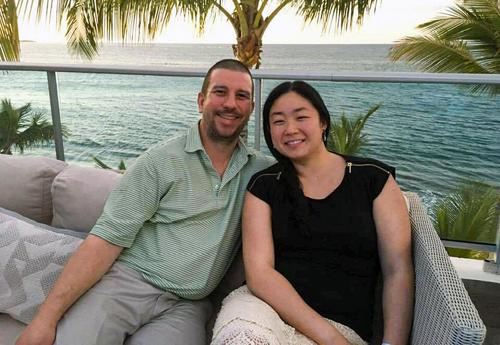
Christopher Quaglin with his wife, Moria, who fears her husband could die without medical attention in federal custody. (Courtesy Quaglin Family)
“Regardless of Mr. McBride’s fictitious assertions,” Hull told The Epoch Times, “inmate Quaglin is and has been receiving the appropriate dietitian-designed diet consistent with his specific dietary requirements and the appropriate level of medical services consistent with his diagnosis.”
Rep. Marjorie Taylor Greene (R-Ga.) toured the D.C. jail with Rep. Louie Gohmert (R-Texas) in November, then issued a 28-page report titled “Unusually Cruel.” The report said the conditions for the Jan. 6 detainees were “inhumane.”
Couy Griffin, the founder of Cowboys for Trump who attended the Jan. 6 Trump rally and was on the Capitol grounds, never went inside the Capitol building. He was charged with entering and remaining in a restricted building, and disorderly and disruptive conduct in a restricted building. He was arrested and jailed, but eventually released while awaiting trial.
“I spent the next nine days in that cell in total solitary confinement. No shower, no phone, no attorney,” Griffin said in the film “Capitol Punishment.” The guards, he said, often chanted “F Trump! F Trump!” and called him an “[expletive] white cracker.” He complained about his treatment to the deputy warden, who he said told him, “The only job these guards have is to keep your chest moving up and down.”
Richard Barnett of Gravette, Arkansas, faced seven charges for his alleged actions on Jan. 6, including sitting in the office chair of House Speaker Nancy Pelosi, captured in a now-iconic news photograph.
One day during his four-month detention, Barnett experienced tightness in his chest and arm pain. He called for help, but the guard who responded only mocked and laughed at him. Barnett then called out to a female staff member, who said she would get help. “Richard [lay] there for a significant period of time—certainly enough for him to die,” read McBride’s report on jail conditions, which he sent to Amnesty International.
After being given a medical checkup and returned to his cell, Barnett fell asleep. A guard began pounding on the glass door to his cell, jolting him awake so quickly he stood up and then fainted, hitting his head on the sink. Now bleeding from a head wound, Barnett screamed for an hour before help came, the report said.
One day, Barnett’s cell door opened, and some nine officers entered, cuffing his wrists and shackling his legs. Guards violently shook him back and forth, lifted him off his feet by the shackles, and slammed him headfirst into the concrete floor, according to McBride’s report, a copy of which was also sent to the American Civil Liberties Union.
The U.S. Marshals Service conducted a surprise inspection of the D.C. jail facilities in October and interviewed 300 detainees. Conditions at the jail “do not meet the minimum standards of confinement,” the Marshals report said. As a result, the Marshals Service removed all of its detainees and transferred them to facilities in the federal Bureau of Prisons. This didn’t include the Jan. 6 detainees.
Emery Nelson, spokesperson for the Bureau of Prisons, said the agency doesn’t comment on “anecdotal allegations” or provide information about individual inmates.
“The Bureau of Prisons (BOP) is committed to accommodating the needs of federal offenders and ensuring the safety and security of all inmates in our population, our staff, and the public,” Nelson said. “The BOP takes seriously our duty to protect the individuals entrusted in our care.”
Who Died at the Capitol on Jan. 6?
One person was killed at the hands of U.S. Capitol Police, and police action might have contributed to the death of two others, but the four other deaths related to Jan. 6 were either from natural causes or suicides.
Ashli Babbitt was shot in the left shoulder and killed as she crawled through a broken window at the entry to the Speaker’s Lobby. Ashli’s husband, Aaron Babbitt, said a careful examination of video footage from the hallway indicates Ashli was upset with rioters who smashed glass in the double doors. He thinks she panicked and sought escape through the window, only to be shot by Lt. Michael Byrd as a result. She was unarmed and presented no threat to anyone, Aaron Babbitt said.
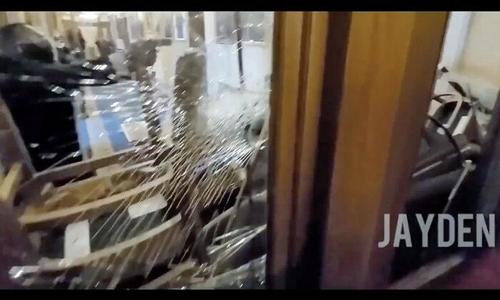
Capitol Police Lt. Michael Byrd aims his Glock 22 at the window where Ashli Babbitt was about to appear. (CapitolPunishmentTheMovie/Bark at the Hole Productions)
Rosanne Boyland, 34, of Georgia, died in or near the West Terrace tunnel at the Capitol. McBride says surveillance video shows Boyland was beaten by a police officer as she lay on the ground. The D.C. medical examiner ruled the death accidental: intoxication from a prescription medication.
Kevin Greeson, 51, of Georgia, died on the Capitol grounds of a heart attack brought on by cardiovascular disease, the medical examiner ruled.
Benjamin Phillips, 50, of Pennsylvania, died of atherosclerosis, heart disease characterized by fatty plaques that build up in the arteries, the medical examiner ruled.
Of the three police officers who died in the weeks following Jan. 6, Sicknick died from natural causes, and Liebengood and Smith died from suicide.
Did Democrats Weaponize Jan. 6?
Rep. Rodney Davis (R-Ill.), ranking member of the Committee on House Administration, accused House Speaker Nancy Pelosi (D-Calif.) and House Democrats of “weaponizing events of January 6th against their political adversaries.”
Davis sent a letter to Pelosi on Jan. 3, 2022, complaining that House Democrats repeatedly obstructed attempts by Republican lawmakers to investigate security vulnerabilities at the U.S. Capitol before and during Jan. 6 violence. The obstruction came through denial of House records and ignoring repeated requests for documents, Davis wrote.
“Unfortunately, over the past twelve months, House Democrats have been more interested in exploiting the events of January 6th for political purposes than in conducting basic oversight of the security vulnerabilities exposed that day,” Davis wrote.
Specifically, lawmakers want to know about a request that former U.S. Capitol Police Chief Steven Sund said he made to then-House Sergeant-at-Arms Paul Irving prior to Jan. 6 for “the assistance of the National Guard,” Davis wrote. Sund reported that Irving was “concerned about the ‘optics’ of a National Guard presence at the Capitol.” During violence on Jan. 6, when Sund asked about getting authorization for the National Guard, Irving responded that he “needed to run it up the chain of command,” the letter said.
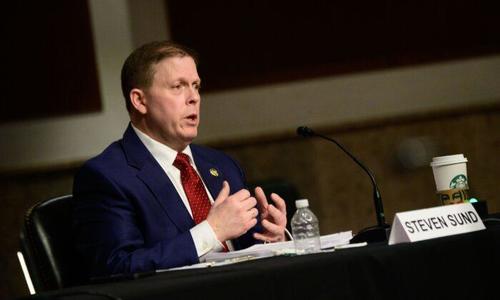
Former U.S. Capitol Police Chief Steven Sund testifies at a Senate Homeland Security and Governmental Affairs and Senate Rules and Administration committees joint hearing on Capitol Hill in Washington on Feb. 23, 2021. (Erin Scott/Pool/AFP via Getty Images)
In February 2021 testimony before the U.S. Senate, Irving denied Sund’s claims. Republican lawmakers then requested access to Irving’s communications to substantiate that denial. Davis said he wrote to House General Counsel Douglas Letter to request those records, but Letter never replied.
“Both the Sergeant at Arms and the chief administration officer failed to produce any documents to Republicans pursuant to our requests,” Davis wrote, “suggesting that these House officers may be providing documents only to Democrats on a partisan basis.”
Davis said Republicans want to know why Sund’s Jan. 4, 2021, request for National Guard support on Jan. 6 was denied, and whether Pelosi or her staff ordered the refusal. They also want to know what conversations occurred during Capitol violence on Jan. 6, when Sund again asked for National Guard help. Finally, they want to know why the select committee on Jan. 6, appointed by Pelosi, won’t examine the speaker’s role “in ensuring the proper House security preparations,” the letter said.
When asked whether the speaker had responded to Davis, Henry Connelly, Pelosi’s communications director, referred The Epoch Times to a statement issued by House Administration Committee Chair Zoe Lofgren (D-Calif.).
“The Ranking Member’s letter is pure revisionist fiction. The Chief Administrative Officer and House Sergeant at Arms have already notified Ranking Member Davis they are complying with preservation requests and will fully cooperate with various law enforcement investigations and bonafide congressional inquiries,” Lofgren said in the statement.
From the inception of the Select Committee to Investigate the January 6th Attack on the United States Capitol, Republican leadership discounted its work because Pelosi rejected two of the five Republicans chosen by House Minority Leader Kevin McCarthy (R-Calif.) for the probe. McCarthy then withdrew his picks. Pelosi appointed Reps. Liz Cheney (R-Wyo.) and Adam Kinzinger (R-Ill.) to serve on the nine-member panel.
The select committee could issue at least an interim report by mid-2022 and a final report in the fall, committee sources told several media outlets. Committee chairman Rep. Bennie Thompson (D-Miss.) said in December that there was no set schedule for public hearings to release the group’s findings.
The Epoch Times asked the Department of Justice for comment on the presence of federal agents on Jan. 6, but didn’t receive a reply by press time. The Epoch Times contacted Epps through his business for comment, but didn’t receive a reply by press time.



